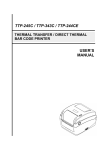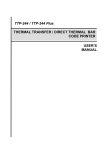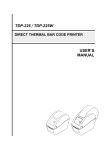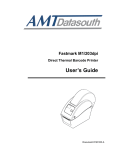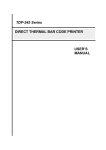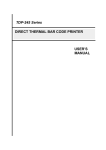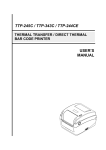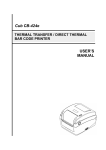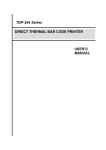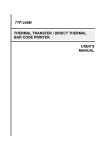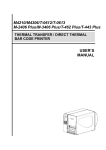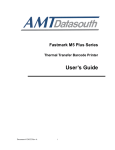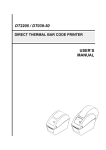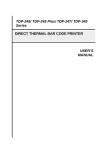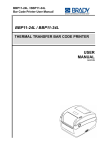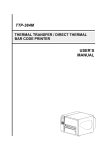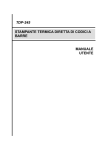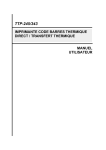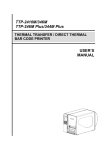Download TTP-245C / TTP-343C / TTP-244CE USER`S MANUAL
Transcript
TTP-245C / TTP-343C / TTP-244CE THERMAL TRANSFER / DIRECT THERMAL BAR CODE PRINTER USER’S MANUAL Contents Copyright Declaration....................................... i 1. Introduction ........................................... ii 1.1 Product Introduction ...............................................................................ii 1.2 Compliances ............................................................................................ii 2. Operations Overview ..................................... 1 2.1 Unpacking and Inspection ......................................................................1 2.2 Printer Overview ......................................................................................2 2.2.1 Front View ......................................................................................2 2.2.2 Interior view....................................................................................4 2.2.3 Rear View........................................................................................5 3. Setup ................................................. 6 3.1 Setting Up the Printer ..............................................................................6 3.2 Open / Close the Top Cover ....................................................................7 3.3 Loading the Ribbon .................................................................................8 3.4 Loading the Media ................................................................................. 11 3.4.1 Loading the media ....................................................................... 11 3.4.2 External Label Roll Mount Installation (Option) ........................13 3.4.3 Loading Media in Peel-off Mode (Option) ..................................15 3.4.4 Loading Media in Cutter Mode (Option).....................................17 3.5 Diagnostic Tool ......................................................................................18 3.5.1 Start the Diagnostic Tool.............................................................18 3.5.2 Printer Function (Calibrate sensor, Ethernet setup, RTC setup………) ..........................................................................................19 3.6 Install SD Memory Card.........................................................................20 4. LED and Button Functions ................................ 22 4.1 LED indicator .........................................................................................22 4.2 Regular button function ........................................................................22 4.3 Power on utilities ...................................................................................22 4.3.1 Ribbon and Gap/Black Mark Sensor Calibration ......................23 4.3.2 Gap/Black Mark Calibration, Self-test and Dump Mode ...........24 4.3.3 Printer Initialization......................................................................26 4.3.4 Set Black Mark Sensor as Media Sensor and Calibrate the Black Mark Sensor ..........................................................................................27 4.3.5 Set Gap Sensor as Media Sensor and Calibrate the Gap Sensor 27 i 4.3.6 Skip AUTO.BAS............................................................................27 5. Troubleshooting ........................................ 28 5.1 LED Status..............................................................................................28 5.2 Print Quality ...........................................................................................29 6. Maintenance ........................................... 30 Revise History ........................................... 32 ii Copyright Declaration Information in this subject to change without notice and does not represent a commitment on the part of TSC Auto ID Technology Co., Ltd.. No part of this manual may be reproduced or transmitted in any form by any means, for any purpose other than the purchaser’s personal use, without the expressed written permission of TSC Auto ID Technology Co., Ltd.. i 1. Introduction 1.1 Product Introduction Thank you for purchasing TSC bar code printer. Although the printer takes only a small amount of space, it delivers reliable, superior performance. This printer provides both thermal transfer and direct thermal printing at user selectable speed of: 2.0, 3.0, 4.0 or 5.0 ips, for TTP-245C series; 2.0 or 3.0 ips for TTP-343C series. It accepts roll feed, die-cut, and fan-fold labels for both thermal transfer and direct thermal printing. All common bar codes formats are available. Fonts and bar codes can be printed in 4 directions, 8 different alphanumeric bitmap fonts and a build-in true type font capability. You will enjoy high throughput for printing labels with this printer. 1.2 Compliances CE Class B: EN55022: 1998+A1: 2000+A2: 2003 EN55024: 1998+A1: 2001+A2: 2003 IEC 61000-4 Series EN61000-3-2: 2006 & EN61000-3-3: 1995+A1: 2001 FCC Part 15, Class B UL, CUL C-Tick: CFR 47, Part 15/CISPR 22 3rd Edition: 1997, Class B ANSI C63.4: 2003 Canadian ICES-003 TÜV-GS: EN60950: 2000 Wichtige Sicherheits-Hinweise 1.Bitte lesen Sie Diese Hinweis sorgfältig durch 2.Heben Sie diese Anleitung fűr den späteren Gebrauch auf. 3.Vor jedem Reinigen ist das Gerät vom Stromentz zu trennen. Verwenden Sie Keine Flűssig-oder Aerosolreiniger. Am besten eignet sich ein angefeuchtetes Tuch zur Reinigung. 4.Die Netzanschlußsteckdose soll nahe dem Gerät angebraucht und leicht zugänglich sein. 5.Das Gerät ist vor Feuchtigkeit zu schűtzen. 6.Bei der Aufstellung des Gerätes ist auf sicheren Stand zu achten. Ein Kippen oder Fallen könnte Beschädigungen hervorrufen. 7.Beáchten Sie beim Anschluß an das stromnetz die Anschlußwerte. 8. Dieses das Gerät kann bis zu einer Außentemperatur von maximal 40℃ betieben werden. ii WARNING HAZARDOUS MOVING PARTS KEEP FINGERS AND OTHER BODY PARTS AWAY CAUTION RISK OF EXPLOSION IF BATTERY IS REPLACED BY AN INCORRECT TYPE. DISPOSE OF USED BATTERIES ACCORDING TO THE INSTRUCTIONS WARNUNG! GEFÄHRLICHE BEWEGLICHE TEILE – FINGER UND ANDERE KÖRPERTEILE FERNHALTEN! VORSICHT! EXPLOSIONSGEFAHR BEI ERSATZ DER BATTERIE DURCH UNZULÄSSIGEN TYP. VERBRAUCHTE BATTERIEN IMMER VORSCHRIFTSGEMÄSS ENTSORGEN! Note: * Continuous printing will cause printer motor overheat. Printer will stop printing automatically about 10~15 minutes until motor is cooling down. Please don't turn off power when printer pauses or the data transfered to printer buffer will be lost. * The maximum printing ratio per dot line is 15% for this printer. To print the full web black line, the maximum black line height is limited to 40 dots, which is 5mm for 203 DPI resolution printer and 3.3mm for 300 DPI resolution printer. iii 2. Operations Overview 2.1 Unpacking and Inspection This printer has been specially packaged to withstand damage during shipping. Please carefully inspect the packaging and printer upon receiving the bar code printer. Please retain the packaging materials in case you need to reship the printer. Unpacking the printer, the following items are included in the carton. One printer unit One Windows labeling software/Windows driver CD disk One quick installation guide One power cord One auto switching power supply One USB interface cable If any parts are missing, please contact the Customer Service Department of your purchased reseller or distributor. 2.2 Printer Overview 2.2.1 Front View 3 1 4 5 2 6 1. Ribbon access cover 2. Top cover open lever 3. Media view window 4. LED indicator 5. Feed button 6. SD card socket * Recommended SD card specification. SD card spec SD card capacity Approved SD card manufacturer V1.0, V1.1 128 MB SanDisk, Transcend V1.0, V1.1 256 MB SanDisk, Transcend, Panasonic V1.0, V1.1 512 MB SanDisk, Transcend, Panasonic V1.0, V1.1 1 GB SanDisk, Transcend, Panasonic V2.0 SDHC CLASS 4 4 GB V2.0 SDHC CLASS 6 4 GB SanDisk, Transcend, Panasonic V1.0, V1.1 microSD 128 MB Transcend, Panasonic V1.0, V1.1 microSD 256 MB Transcend, Panasonic 2 V1.0, V1.1 microSD 512 MB Panasonic V1.0, V1.1 microSD 1 GB Transcend, Panasonic V2.0 SDHC CLASS 4 microSD 4 GB Panasonic V2.0 SDHC CLASS 6 microSD 4 GB Transcend V1.0, V1.1 miniSD 128 MB Transcend, Panasonic V1.0, V1.1 miniSD 256 MB Transcend, Panasonic V1.0, V1.1 miniSD 512 MB Transcend, Panasonic V1.0, V1.1 miniSD 1 GB Transcend, Panasonic V2.0 SDHC CLASS 4 miniSD 4 GB Transcend V2.0 SDHC CLASS 6 miniSD 4 GB - The DOS FAT file system is supported for the SD card. - Folders/files stored in the SD card should be in the 8.3 filename format - The miniSD/microSD card to SD card slot adapter is required. 3 2.2.2 Interior view 7 1 8 2 9 10 11 3 4 12 5 6 1. Ribbon rewind hub 2. Ribbon rewind gear 3. Gap sensor (receiver) 4. Media holder 5. Media holder lock switch 6. Gap sensor (transmitter) 7. Printhead 8. Ribbon supply hub 9. Top cover support 10. Media guide adjustment knob 11. Black mark sensor 12. Platen roller 4 2.2.3 Rear View 7 1 2 3 4 1. Ethernet interface 2. USB interface 3. Centronics interface 4. RS-232C interface 5. Power jack socket 6. Power switch 7. Fan-fold paper entrance chute 5 5 6 3. Setup 3.1 Setting Up the Printer 1. Place the printer on a flat, secure surface. 2. Make sure the power switch is off. 3. Connect the printer to the computer with the provided USB cable. 4. Plug the power cord into the AC power cord socket at the rear of the printer, and then plug the power cord into a properly grounded power outlet. Ethernet RJ-45 interface Plug Power Switch USB interface Centronics interface RS-232C interface Power Supply 6 3.2 Open / Close the Top Cover 1. Open the printer top cover by pulling the green tabs located on each side towards the front of the printer, then lift the top cover to the maximum open angle. 2. A top cover support at the rear of the printer will engage with lower inner cover to hold the printer top cover open. 3. Hold the top cover and press the top cover support to disengage the top cover support with lower inner cover. Gently close the top cover. 7 3.3 Loading the Ribbon 1. Open the printer’s top cover by pulling the green top cover open levers located on each side of the printer and lifting the top cover to the maximum open angle. 2. Open the ribbon access cover. Note: 1. In normal printing mode, ribbon access cover can be opened while opens the top cover. Ribbon access cover can be closed while top cover is open or close. 2. In peeler and cutter mode, please open the top cover then the ribbon access cover can be opened or closed. 3. Insert the ribbon right side onto the supply hub. Align the notches on the left side and mount onto the spokes. 4. Insert the paper core right side onto the rewind hub. Align the notches on the left side and mount onto the spokes. 8 5. Stick the ribbon onto the ribbon rewind paper core. 6. Turn the ribbon rewind gear until the ribbon plastic leader is thoroughly wound and the black section of the ribbon covers the print head. Close the ribbon access cover and the top cover. 9 z Loading Path for Ribbon 10 3.4 Loading the Media 3.4.1 Loading the media 1. Open the printer top cover by pulling the green tabs located on each side towards the front of the printer, then lift the top cover to the maximum open angle. 2. Separate and hold open the media holders. 3. Place the roll between the holders and close them onto the core. 4. Press down the media holder lock switch to hold the label roll firmly. 5. Place the paper, printing side face up, through the media sensor and place the label leading edge onto the platen roller. Move the media guides to fit the label width by turning the guide adjuster knob. Disengage the top cover support and close the top 11 cover gently. 6. Use “Diagnostic Tool” to set the media sensor type and calibrate the selected sensor. (Start the “Diagnostic tool” Æ Select the “Printer Configuration” tab Æ Click the “Calibrate Sensor” button ) Please refer to the diagnostic utility quick start guide for more information. Note: Please calibrate the gap/black mark sensor when changing media. z Loading path for roll labels 12 3.4.2 External Label Roll Mount Installation (Option) 1. Attach an external paper roll mount on the bottom of the printer. 2. Insert a 3” label spindle into a paper roll. And install it on the external paper roll mount. 3. Open the printer’s top cover and separate the media holders to fit the media width. 4. Press down the media holder lock switch to fix the media holder. 5. Feeds the media through the rear external label entrance chute. And place the paper, printing side face up, through the media sensor and place the label leading edge onto the platen roller. 13 6. Move the media guides to fit the label width by turning the guide adjuster knob. 7. Disengage the top cover support and close the top cover gently. 8. Use “Diagnostic Tool” to set the media sensor type and calibrate the selected sensor. (Start the “Diagnostic tool” Æ Select the “Printer Configuration” tab Æ Click the “Calibrate Sensor” button) Please refer to the diagnostic utility quick start guide for more information. Note: Please calibrate the gap/black mark sensor when changing media. 14 3.4.3 Loading Media in Peel-off Mode (Option) 1. Refer to section 3.4.1 to load the media. 2. Feed the paper, printing side facing up, through the paper guide and pass over the platen. 3. Move the media guides to fit the label width by turning the guide adjuster knob. 4. Use “Diagnostic Tool” to set the media sensor type and calibrate the selected sensor. (Start the “Diagnostic tool” Æ Select the “Printer Configuration” tab Æ Click the “Calibrate Sensor” button) Please refer to the diagnostic utility quick start guide for more information. 5. Open the peel-off panel by pulling it out. Peel-off panel 6. Lead the media through the backing paper opening, beneath the peel-off roller. Peel-off roller Backing paper opening 7. Push the peel-off panel back to the printer 15 8. Disengage the top cover support and close the top cover gently. 9. Peeling will automatically start. Press the FEED button to test. Backing paper (Liner) Note: Please calibrate the gap/black mark sensor when changing media. 16 3.4.4 Loading Media in Cutter Mode (Option) 1. Refer to section 3.4.1 to load the media. 2. Lead the media through the cutter paper opening. 3. Move the media guides to fit the label width by turning the guide adjuster knob. 4. Disengage the top cover support and close the top cover gently. 5. Use “Diagnostic Tool” to set the media sensor type and calibrate the selected sensor. (Start the “Diagnostic tool” Æ Select the “Printer Configuration” tab Æ Click the “Calibrate Sensor” button) Please refer to the diagnostic utility quick start guide for more information. Note: Please calibrate the gap/black mark sensor when changing media. 17 3.5 Diagnostic Tool The Diagnostic Utility is a toolbox that allows users to explore the printer's settings and status; change printer settings; download graphics, fonts, and firmware; create printer bitmap fonts; and to send additional commands to the printer. Using this convenient tool, you can explore the printer status and settings and troubleshoot the printer. Note: This utility works with printer firmware V6.00 and later versions. 3.5.1 Start the Diagnostic Tool 1. Double click on the Diagnostic tool icon to start the software. 2. There are four features (Printer Configuration, File Manager, Bitmap Font Manager, Command Tool) included in the Diagnostic utility. Features tab Interface Printer functions Printer setup Printer Status 18 3.5.2 Printer Function (Calibrate sensor, Ethernet setup, RTC setup………) 1. Select the PC interface connected with bar code printer. 2. Click the “Function” button to setting. 3. The detail functions in the Printer Function Group are listed as below. Function Description Factory Default Initialize the printer and restore the settings to factory default. Dump Text To activate the printer dump mode. Configuration Page Print printer configuration. RTC Setup Synchronize printer Real Time Clock with PC. Calibrate Sensor Calibrate the sensor specified in the Printer Setup group media sensor field. Reset Printer Reboot the printer. Print Test Page Print a test page. Ignore AUTO.BAS Ignore the downloaded AUTO.BAS program. Ethernet Setup Setup the IP address, subnet mask, gateway for the on board Ethernet. Note: For more information about Diagnostic Tool, please refer to the diagnostic utility quick start guide in the CD disk \ Utilities directory. 19 3.6 Install SD Memory Card 1. Open the SD memory card cover. 2. Plug in the SD card on main board. 3. Close the memory card cover. * Recommended SD card specification. SD card spec SD card capacity Approved SD card manufacturer V1.0, V1.1 128 MB SanDisk, Transcend V1.0, V1.1 256 MB SanDisk, Transcend, Panasonic V1.0, V1.1 512 MB SanDisk, Transcend, Panasonic V1.0, V1.1 1 GB SanDisk, Transcend, Panasonic V2.0 SDHC CLASS 4 4 GB V2.0 SDHC CLASS 6 4 GB SanDisk, Transcend, Panasonic V1.0, V1.1 Transcend, Panasonic microSD 128 MB 20 V1.0, V1.1 microSD 256 MB Transcend, Panasonic V1.0, V1.1 microSD 512 MB Panasonic V1.0, V1.1 microSD 1 GB Transcend, Panasonic V2.0 SDHC CLASS 4 microSD 4 GB Panasonic V2.0 SDHC CLASS 6 microSD 4 GB Transcend V1.0, V1.1 miniSD 128 MB Transcend, Panasonic V1.0, V1.1 miniSD 256 MB Transcend, Panasonic V1.0, V1.1 miniSD 512 MB Transcend, Panasonic V1.0, V1.1 miniSD 1 GB Transcend, Panasonic V2.0 SDHC CLASS 4 miniSD 4 GB Transcend V2.0 SDHC CLASS 6 miniSD 4 GB - The DOS FAT file system is supported for the SD card. - Folders/files stored in the SD card should be in the 8.3 filename format - The miniSD/microSD card to SD card slot adapter is required. 21 4. LED and Button Functions This printer has one button and one three-color LED indicator. By indicating the LED with different color and pressing the button, printer can feed labels, pause the printing job, select and calibrate the media sensor, print printer self-test report, reset printer to defaults (initialization). Please refer to the button operation below for different functions. 4.1 LED indicator LED Color Description Green/ Solid This illuminates that the power is on and the device is ready to use. Green/ Flash This illuminates that the system is downloading data from PC to memory or the printer is paused. Amber This illuminates that the system is clearing data from printer. Red / Solid This illuminates printer head open, cutter error. Red / Flash This illuminates a printing error, such as head open, paper empty, paper jam, ribbon empty, or memory error etc. 4.2 Regular button function 1. Feed labels When the printer is ready, press the button to feed one label to the beginning of next label. 2. Pause the printing job When the printer is printing, press the button to pause a print job. When the printer is paused the LED will blink green. Press the button again to continue the printing job. 4.3 Power on utilities There are six power-on utilities to set up and test printer hardware. These utilities are activated by pressing FEED button then turning on the printer power simultaneously and release the button at different color of LED. Please follow the steps below for different power-on utilities. 1. Turn off the power switch. 2. Hold on the button then turn on the power switch. 22 3. Release the button when LED indicates with different color for different functions. Power on utilities The LED color will be changed as following pattern: LED color Amber Red Amber Green Functions (5 blinks) (5 blinks) (5 blinks) 1. Ribbon Sensor Calibration and Gap / Release Green/Amber Red/Amber Solid green (5 blinks) (5 blinks) black mark sensor calibration 2. Gap / black mark sensor calibration, Release Self-test and enter dump mode 3. Printer initialization Release 4. Set black mark sensor as media Release sensor and calibrate the black mark sensor 5. Set gap sensor as media sensor and Release calibrate the gap sensor 6. Skip AUTO.BAS Release 4.3.1 Ribbon and Gap/Black Mark Sensor Calibration Gap/black mark sensor sensitivity should be calibrated at the following conditions: 1. A brand new printer 2. Change label stock. 3. Printer initialization. Please follow the steps below to calibrate the ribbon and gap/black mark sensor. 1. Turn off the power switch. 2. Hold on the button then turn on the power switch. 3 Release the button when LED becomes red and blinking. (Any red will do during the 5 blinks). It will calibrate the ribbon sensor and gap/black mark sensor sensitivity. The LED color will be changed as following order: Amber Æ red (5 blinks) Æ amber (5 blinks) Æ green (5 blinks) Æ green/amber (5 blinks) Æ red/amber (5 blinks) Æ solid green Note: Please select gap or black mark sensor by sending GAP or BLINE command to printer prior to calibrate the sensor. For more information about GAP and BLINE command, please refer to TSPL2 programming manual. 23 4.3.2 Gap/Black Mark Calibration, Self-test and Dump Mode While calibrate the gap/black mark sensor, printer will measure the label length, print the internal configuration (self-test) on label and then enter the dump mode. To calibrate gap or black mark sensor, depends on the sensor setting in the last print job. Please follow the steps below to calibrate the sensor. 1.Turn off the power switch. 2. Hold on the button then turn on the power switch. 3. Release the button when LED becomes amber and blinking. (Any amber will do during the 5 blinks) The LED color will be changed as following order. Amber Æ red (5 blinks) Æ amber (5 blinks) Æ green (5 blinks) Æ green/amber (5 blinks) Æ red/amber (5 blinks) Æ solid green 4. It calibrates the sensor and measures the label length and prints internal settings then enter the dump mode. Note: Please select gap or black mark sensor by Diagnostic Tool or by GAP or BLINE command prior to calibrate the sensor. For more information about GAP and BLINE command, please refer to TSPL2 programming manual. 24 Self-test Printer will print the printer configuration after gap/black mark sensor calibration. Self-test printout can be used to check if there is any dot damage on the heater element, printer configurations and available memory space. Print head test pattern Printer model name & Main board firmware version Printed mileage Main board firmware checksum Serial port setting Code page Country code Print speed Print darkness Label size (width, height) Gap size (vertical gap, offset) Sensor sensitivity File management information Dump mode Printer will enter dump mode after printing printer configuration. In the dump mode, all characters will be printed in 2 columns as following. The left side characters are received from your system and right side data are the corresponding hexadecimal value of the characters. It allows users or engineers to verify and debug the program. Hex decimal data related to left column of ASCII data ASCII Data 25 Note: 1. Dump mode requires 4” wide paper width. 2. Turn off / on the power to resume printer for normal printing. 3. Press FEED button to back to the previous menu. 4.3.3 Printer Initialization Printer initialization is used to clear DRAM and restore printer settings to defaults. The only one exception is ribbon sensitivity, which will note be restored to default. Printer initialization is activated by the following procedures. 1. Turn off the power switch. 2. Hold on the button then turn on the power switch. 3. Release the button when LED turns green after 5 amber blinks. (Any green will do during the 5 blinks). The LED color will be changed as following: Amber Æ red (5 blinks) Æ amber (5 blinks) Æ green (5 blinks) Æ green/amber (5 blinks) Æ red/amber (5 blinks) Æ solid green Printer configuration will be restore to defaults as below after initialization. Parameter Speed Default setting 127 mm/sec (5 ips) (203DPI) 76 mm/sec (3 ips) (300DPI) Density 8 Label Width 4” (101.5 mm) Label Height 4” (101.5 mm) Sensor Type Gap sensor Gap Setting 0.12” (3.0 mm) Print Direction 0 Reference Point 0,0 (upper left corner) Offset 0 Tear Mode On Peel off Mode Off Cutter Mode Off Serial Port Settings 9600 bps, none parity, 8 data bits, 1 stop bit Code Page 850 Country Code 001 Clear Flash Memory No IP Address DHCP 26 4.3.4 Set Black Mark Sensor as Media Sensor and Calibrate the Black Mark Sensor Please follow the steps as below. 1. Turn off the power switch. 2. Hold on the button then turn on the power switch. 3. Release the button when LED turns green/amber after 5 green blinks. (Any green/amber will do during the 5 blinks). The LED color will be changed as following: Amber Æ red (5 blinks) Æ amber (5 blinks) Æ green (5 blinks) Æ green/amber (5 blinks) Æ red/amber (5 blinks) Æ solid green 4.3.5 Set Gap Sensor as Media Sensor and Calibrate the Gap Sensor Please follow the steps as below. 1. Turn off the power switch. 2. Hold on the button then turn on the power switch. 3. Release the button when LED turns red/amber after 5 green/amber blinks. (Any red/amber will do during the 5 blinks). The LED color will be changed as following: Amber Æ red (5 blinks) Æ amber (5 blinks) Æ green (5 blinks) Æ green/amber (5 blinks) Æ red/amber (5 blinks) Æ solid green 4.3.6 Skip AUTO.BAS TSPL2 programming language allows user to download an auto execution file to flash memory. Printer will run the AUTO.BAS program immediately when turning on printer power. The AUTO.BAS program can be interrupted without running the program by the power-on utility. Please follow the procedures below to skip an AUTO.BAS program. 1. Turn off printer power. 2. Press the FEED button and then turn on power. 3. Release the FEED button when LED becomes solid green. The LED color will be changed as following: Amber Æ red (5 blinks) Æ amber (5 blinks) Æ green (5 blinks) Æ green/amber (5 blinks) Æ red/amber (5 blinks) Æ solid green 4. Printer will be interrupted to run the AUTO.BAS program. 27 5. Troubleshooting The following guide lists the most common problems that may be encountered when operating this bar code printer. If the printer still does not function after all suggested solutions have been invoked, please contact the Customer Service Department of your purchased reseller or distributor for assistance. 5.1 LED Status This section lists the common problems that according to the LED status and other problems you may encounter when operating the printer. Also, it provides solutions. LED Status / Color OFF Printer Status No response Possible Cause No power Recovery Procedure * Turn on the power switch. * Check if the green LED is lit on power supply. If it is not lit on, power supply is broken. * Check both power connections from the power cord to the power supply and from the power supply to the printer power jack if they are connected securely. Solid Green ON The printer is ready to * No action necessary. use Green with Pause The printer is paused * Press the FEED button to resume for printing. blinking Red with blinking Error The out of label or 1. Out of label or ribbon ribbon or the printer * Load a roll of label and follow the instructions in setting is not correct loading the media then press the FEED button to resume for printing. * Load a roll of ribbon and follow the instructions in loading the ribbon then press the FEED button to resume for printing. 2. Printer setting is not correct * Initialize the printer by instructions in “Power on Utility” or “Diagnostic Tool”. Note: Printer status can be easily shown on the Diagnostic Tool. For more information about the Diagnostic Tool, please refer to the instruction in the software CD disk. 28 5.2 Print Quality Problem Possible Cause Check if interface cable is well Recovery Procedure Re-connect cable to interface. connected to the interface connector. The serial port cable pin configuration is Please replace the cable with pin to pin Not Printing not pin to pin connected. connected. The serial port setting is not consistent Please reset the serial port setting. between host and printer. The port specified in the Windows driver Select the correct printer port in the is not correct. driver. The Ethernet IP, subnet mask, gateway Configure the IP, subnet mask and is not configured properly. No print on the label Label or ribbon loaded not correctly. Ribbon run out. Continuous feeding labels gateway. Follow the instructions in loading the media or loading the ribbon. Loading the ribbon. The printer setting may go wrong. Please do the initialization and gap/black mark calibration. Gap/black mark sensor sensitivity is not Calibrate the gap/black mark sensor. set properly (sensor sensitivity is not enough) Paper Jam Make sure label size is set properly. Set label size exactly as installed paper in the labeling software or program. Labels may be stuck inside the printer Remove the stuck label. mechanism near the sensor area. Poor Print Quality Top cover is not closed properly. Close the top cover completely and make sure the right side and left side levers are latched properly Check if supply is loaded correctly. Reload the supply. Ribbon and media are incompatible. Change the ribbon or label combination. Clean the print head. Check if dust or adhesives are accumulated on the print head. Check if print density is set properly. Check print head test pattern if head element is damaged. 29 Adjust the print density and print speed. Run printer self-test and check the print head test pattern if there is dot missing in the pattern. 6. Maintenance This session presents the clean tools and methods to maintain your printer. 1. Please use one of following material to clean the printer. Cotton swab (Head cleaner pen) Lint-free cloth Vacuum / Blower brush 100% ethanol 2. The cleaning process is described as following: Printer Part Method Interval 1. Always turn off the printer before cleaning Clean the print head when changing a new label roll the print head. 2. Allow the print head to cool for a minimum of one minute. 3. Use a cotton swab and 100% ethanol to clean the print head surface. Print Head Platen Roller 1. Turn the power off. Clean the platen roller when changing 2. Rotate the platen roller and wipe it a new label roll thoroughly with 100% ethanol and a cotton swab, or lint-free cloth. Tear Bar/Peel Bar Use the lint-free cloth with 100% ethanol to As needed wipe it. Sensor Compressed air or vacuum Monthly Exterior Wipe it with water-dampened cloth As needed Interior Brush or vacuum As needed Note: z Do not touch printer head by hand. If you touch it careless, please use ethanol to clean it. 30 z Please use 100% Ethenol. DO NOT use medical alcohol, which may damage the printer head. z Regularly clean the print head and supply sensors once change a new ribbon to keep printer performance and extend printer life. z Continuous printing will cause printer motor overheat. Printer will stop printing automatically about 10~15 minutes until motor is cooling down. Please don't turn off power when printer pauses or the data transfered to printer buffer will be lost. z The maximum printing ratio per dot line is 15% for this printer. To print the full web black line, the maximum black line height is limited to 40 dots, which is 5mm for 203 DPI resolution printer and 3.3mm for 300 DPI resolution printer. 31 Revise History Date Content Editor Revise 3.4.3 section (Loading media in peel-off mode) Camille Revise 3.4.2 section (External label roll mount installation/Option) Camille 2009/2/4 Revise 3.4.4 section (Loading media in cutter mode/Option) Camille 2009/3/11 Revise 2.2.1 & 3.6 sections (Recommended SD card specification) Camille 2008/8/6 2008/11/17 32 TSC Auto ID Technology Co., Ltd. Headquarters / Factory No. 35, Sec. 2, Ligong 1st Rd., Wujie Town , I-Lan County 268, Taiwan, R.O.C. TEL: +886-3-990-6677 FAX: +886-3-990-5577 Web site: www.tscprinters.com E-mail: [email protected] [email protected] 33 Taipei Office 11F, No. 205, Sec. 3, Beishin Rd., Shindian City, Taipei 231, Taiwan, R.O.C. TEL: +886-2-8913-1308 FAX: +886-2-8913-1808







































